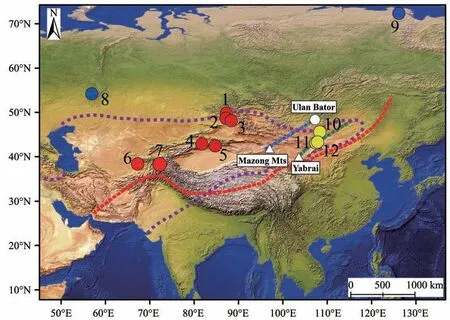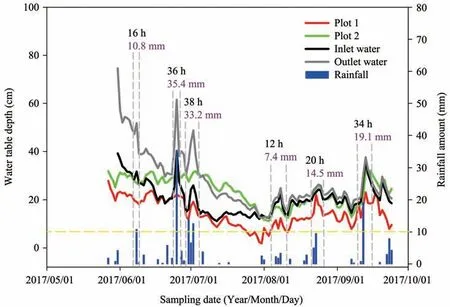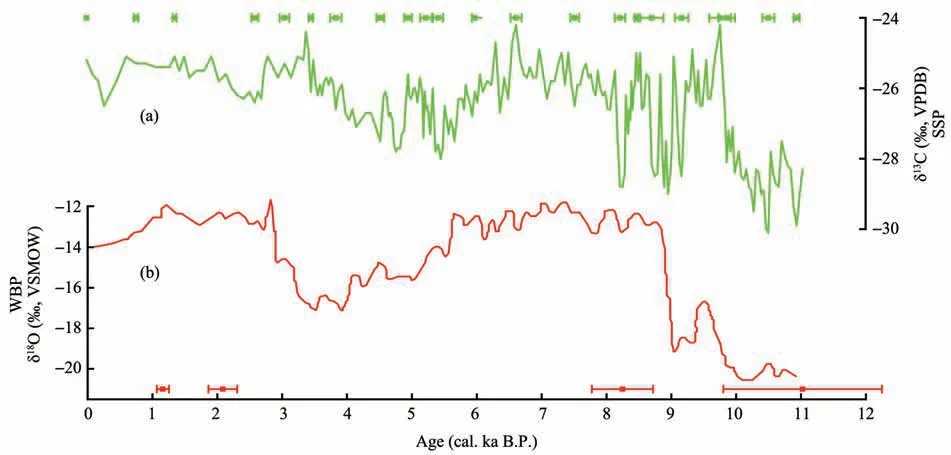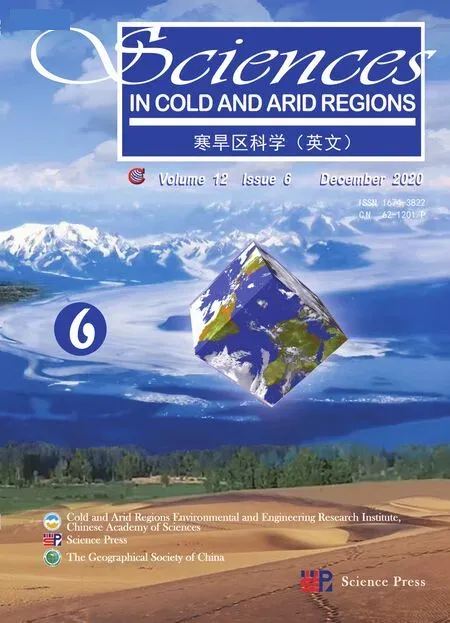Holocene precipitation δ18O as an indicator of temperature history in arid central Asia:an overview of recent advances
ZhiGuo Rao,YiPing Tian,YunXia Li,HaiChun Guo,XinZhu Zhang,Guang Han,XinPing Zhang
College of Resources and Environmental Sciences,Hunan Normal University,Changsha,Hunan 410081,China
ABSTRACT Holocene δ18O records from various archives(ice cores,cave stalagmites,and peat sediments)from the Xinjiang region of northwestern China, in arid central Asia (ACA), are all derived ultimately from local precipitation δ18O (δ18Op). Neverthe‐less, they have been proposed as indicators of different climatic parameters, such as wetness and temperature changes.This article summarizes previously reported records of moisture sources for the Xinjiang region and the results of modern observations conducted at an ice core site and a peat site in the Altai Mountains.The findings are used to propose that the overall positive trends in Holocene δ18O records from the various archives from the Xinjiang region primarily reflect the Holocene's long-term warming trend.It is concluded that more site-specific modern observations are needed to further elu‐cidate the environmental significance of Holocene δ18O records from this region, especially for the separation of different seasonal temperature signals present within δ18O records.
Keywords:arid central Asia;precipitation δ18O;Holocene temperature history;ice core;stalagmite;peat
1 Introduction
The stable oxygen isotopic composition (δ18O) of precipitation (δ18Op) recorded by different geological archives has long been used worldwide as a tracer of hydro-climatic changes (e.g., Dansgaard, 1964; Rozan‐skiet al.,1992).Typical examples are ice core δ18O re‐cords from polar regions as indicators of temperature changes in high latitudes (e.g., Grooteset al., 1993;North Greenland Ice Core Project members, 2004;Seierstadet al., 2014), and cave stalagmite δ18O re‐cords from monsoonal regions as indicators of chang‐es in summer monsoon intensity at low latitudes (e.g.,Wanget al., 2001, 2008; Chenget al., 2016a). These applications highlight the significance and importance of δ18Op-related records in regional hydro-climatic studies.
The history of hydro-climatic change in arid cen‐tral Asia (ACA), especially during the Holocene,has attracted increasing attention in recent years (e.g.,Chenet al., 2008, 2019; Raoet al., 2019a,b). Holo‐cene δ18O records from different archives in ACA, es‐pecially in the Xinjiang region of northwestern China,have been reported, including those from ice cores(Aizenet al., 2016), cave stalagmites (Chenget al.,2012, 2016b; Caiet al., 2017; Liuet al., 2019, 2020),and peat deposits (Xuet al., 2019; Raoet al., 2020).However, their environmental significance has been contested. Therefore, a comprehensive analysis of these Holocene δ18O records and their related mois‐ture sources, together with modern observations, is needed to provide further insights into their paleocli‐matic significance.
2 Holocene δ18O records
Stalagmites are important paleoclimatic archives due to their high-quality chronologies and high-resolu‐tion proxy records, especially in inland arid regions.The stalagmite δ18O records from two caves in the Tianshan Mountains of the Xinjiang region have been reported. The discontinuous stalagmite δ18O record over the past 500 ka (1 ka = 1,000 years) from Kes‐ang Cave in the western Tianshan Mountains (Figure 1; Table 1) has been proposed to record pulsed incur‐sions of the Asian summer monsoon into the arid inte‐rior of Asia. Namely, an enhanced Asian summer monsoon was able to penetrate the study site (Kesang Cave) and supply precipitation with more negative δ18O, whose signal was recorded by the stalagmite δ18O records (Chenget al., 2012; Figure 2a).The sub‐sequently reported Holocene stalagmite δ18O record(Figure 2b) from Tonnelʹnaya Cave, Uzbekistan (Fig‐ure 1; Table 1) displays a similar long-term positive trend to that of the Kesang δ18O record.Together,they have been proposed to represent a supra-regional pat‐tern of climatic variability, which is closely coupled with the Asian monsoon. Notably, the Holocene sta‐lagmite trace element and δ13C records from the two caves lag the corresponding δ18O records by several thousand years. Therefore, they have been proposed as indicators of local hydro-climatic variations (Chengetal., 2016b). The recently reported results on several Holocene stalagmites from Kesang Cave suggest that the stalagmite δ18O record reflects moisture/wetness changes, which indicate a generally wetter climate during the early and middle Holocene. Alternatively,for the drier climatic background of the late Holo‐cene, the temperature has been proposed as the domi‐nant controller of precipitation and stalagmite δ18O for the last 3 ka(Caiet al.,2017;Figure 2c).The more re‐cent stalagmite δ18O records from Baluk Cave in the central Tianshan Mountains (Figure 1; Table 1) show similar more positive trends during the interval of about 8.4−2.7 ka to those from Kesang Cave and Ton‐nelʹnaya Cave. Thus, they also have been proposed as an indicator of regional hydro-climatic variability(Liuet al., 2019). Subsequently, however, Holocene trace element records from Baluk Cave, which show consistent long-term trends similar to those from Kes‐ang Cave and Tonnel'naya Cave, have been proposed as indicators of regional moisture/precipitation,imply‐ing a long-term wetting trend during the Holocene. It is therefore concluded that the Holocene stalagmite δ18O records from the three caves (i.e., Kesang, Ton‐nelʹnaya and Baluk;Figures 2a−2d),which show longterm trends opposite to those of the corresponding trace element records, are not indicators of moisture/precipitation but rather of moisture sources and relat‐ed water vapor transport(Liuet al.,2020).

Table 1 Location information of the study sites

Figure 1 Locations of the study sites.(1)Western Belukha Plateau(WBP;Aizen et al.,2016).(2)Big Black peatland(BBP;Xu et al.,2019).(3)Sahara sand peatland(SSP;Rao et al.,2020).(4)Kesang Cave(Cheng et al.,2012).(5)Baluk Cave(Liu et al.,2019).(6)Tonnelʹnaya Cave(Cheng et al.,2016b).(7)Fedchenko glacier(Aizen et al.,2009).(8)Kinderlinskaya Cave(Baker et al.,2017).(9)Lena River Delta(Meyer et al.,2015).(10−12)Shar-khana,Gurvan Ze'zerd,and Lovon Chombo Caves(Vaks et al.,2013;stalagmite growth in these three caves only occurred at about 400 ka B.P.during the past 500 ka).The red dashed line represents the modern northern limit of the Asian summer monsoon(Chen et al.,2008);the area enclosed by the purple dashed line is arid central Asia(Chen et al.,2019);the blue and green dashed lines represent the northern limits of the Asian summer monsoon during the last interglacial period and the Holocene Optimum period,respectively(Dong et al.,1998)

Figure 2 Comparison of relevant Holocene δ18O records.(a)Kesang stalagmite δ18O record(Cheng et al.,2012);(b)Tonnel'naya stalagmite δ18O record(Cheng et al.,2016b);(c)Kesang stalagmite δ18O record(Cai et al.,2017);(d)Baluk stalagmite δ18O record(Liu et al.,2019,2020);(e)WBP ice core δ18O record(Aizen et al.,2016);(f)BBP peat α-cellulose δ18O record(Xu et al.,2019);(g)SSP peat α-cellulose δ18O record(Rao et al.,2020);(h)Kinderlinskaya stalagmite δ18O record(Baker et al.,2017);(i)Lena River Delta ice wedge δ18O record(Meyer et al.,2015).The different colored lines in a−d represent δ18O data from different stalagmite samples
In addition to cave stalagmites, δ18O records from other archives, such as ice cores andα-cellulose in peat deposits, are also widely recognized to reflect changes in local δ18Op. To the north of the Tianshan Mountains, an ice core δ18O record from the Western Belukha Plateau (WBP; Figure 1; Table 1) in the Si‐berian Altai Mountains shows a long-term positive trend during the Holocene (Aizenet al., 2016; Fig‐ure 2e), which is similar to that of the abovemen‐tioned Tianshan stalagmite δ18O records (Chenget al., 2012, 2016b; Caiet al., 2017; Liuet al., 2019,2020). According to the results from the same site,the WBP ice core δ18O record spanning the interval of 1816−2001 C.E. is an indicator of the mean tem‐perature of the warm-season (March −November)(Hendersonet al.,2006).In the southern Altai Moun‐tains, the recent Holocene peatα-cellulose δ18O re‐cord from the Big Black peatland (BBP; Figure 1;Table 1) has been recommended as a wetness indica‐tor (Xuet al., 2019). Notably, both the δ18O records from Tianshan Kesang Cave stalagmite (Caiet al.,2017) and the Altai BBP peatα-cellulose (Xuet al.,2019) show long-term positive trends during the Ho‐locene and have been proposed as wetness indica‐tors. However, they indicated distinctly different Ho‐locene wetness histories. The Tianshan Kesang Cave stalagmite suggests a wetter early to mid-Holocene and a drier late Holocene (Caiet al., 2017; Figure 2c), whereas the Altai BBP peatα-cellulose is sug‐gested to have responded to a wetter early and late Holocene and a drier mid-Holocene (Xuet al., 2019;Figure 2f). More recently, based on modern observa‐tions of hydrological processes, the peatα-cellulose δ18O record from the Sahara sand peatland (SSP;Fig‐ure 1; Table 1) at a location close to the BBP in the southern Altai Mountains has been proposed as an in‐dicator of winter temperature changes. And it shows a long-term winter warming trend during the Holo‐cene(Raoet al.,2020;Figure 2g).
In summary,the abovementioned Holocene δ18O re‐cords from the Tianshan Mountains and Altai Moun‐tains in ACA all show overall long-term positive trends during the Holocene, even though they have been pro‐posed as indicators of different climatic factors.
3 Insignificant influence of the Asian summer monsoon
The similarity or dissimilarity of the Holocene climatic changes in ACA and monsoonal China has been debated for decades (e.g., Han and Yuan, 1990;Li, 1990; Chenet al., 2008, 2019; Rudayaet al.,2009;Chenget al.,2012,2016b).Resolving this issue is essential for understanding the indicative signifi‐cance of Holocene δ18O records from ACA due to the possible moisture contribution by the Asian summer monsoon to ACA. The Asian summer monsoon may potentially alter the local δ18Opand hence the Holo‐cene δ18O records from different archives (Figure 1).However, we suggest that the influence of the Asian summer monsoon on the Holocene δ18O records from ACA is insignificant, especially for the Holocene δ18O records from the Tianshan and Altai Mountains(Figure 1;Table 1).The reasons include:(i)The mod‐ern northern limit of the Asian summer monsoon(Chenet al.,2008)is far from the locations of the Ho‐locene δ18O records in ACA(Figure 1). (ii)The north‐ern limit of the Asian summer monsoon is proposed to be located in the Shandan-Yabrai region (Figure 1)during the Holocene Optimum period according to the geological records from the eastern desert region of China (Donget al., 1998). The Holocene Optimum period is about 7.5−4.0 ka B.P. (before present,where"present" is normally defined as 1950 C.E.), which is traditionally accepted as representing an enhanced Asian summer monsoon intensity.Similarly,the north‐ern limit of the Asian summer monsoon during the last interglacial period (Marine Isotope Stage 5, MIS5) is proposed to have been located in the Mazong Moun‐tains to the Ulan Bator region (Figure 1; Donget al.,1998), with a generally stronger intensity than during the Holocene. Notably, recent results from the Chi‐nese Loess Plateau (Yanget al., 2015), Lake Dali(Goldsmithet al., 2017) and Lake Zhongquanzi (Lanet al., 2020) in northern China all demonstrated a mi‐gration of about 300−400 km northward in the north‐ern limit of the Asian summer monsoon during the middle Holocene and the warmer Medieval Warm Pe‐riod. This observation supports the classic results from the eastern desert region of China (Donget al.,1998; Figure 1) that there is a long distance between the Holocene δ18O records from the Altai and Tian‐shan Mountains in ACA (Figure 1) and the northern limit of the Asian summer monsoon during the middle Holocene. (iii) From a much longer geological per‐spective (i.e., over the past 500 ka), it has been dem‐onstrated that the wet conditions that enabled stalag‐mite growth only occurred in the Gobi Desert in southern Mongolia(Figure 1;Table 1)at about 400 ka B.P.(during the warmest interglacial MIS11).This im‐plies that only during this period, with the strongest Asian summer monsoon intensity over the past 500 ka(Vakset al., 2013), was the Asian summer monsoon rainfall able to reach the Gobi Desert in southern Mongolia.
In summary, the long distances between the sites of Holocene δ18O records in ACA and the northern limit of the Asian summer monsoon during the Holo‐cene Optimum and the last interglacial and MIS11(Figure 1) demonstrate the insignificant influence of Asian summer monsoon moisture on the abovemen‐tioned Holocene δ18O records from ACA.
4 Modern moisture sources and δ18Op
The results from two snow/firn cores from the Fedchenko glacier in the Pamirs within Tajikistan(Figure 1; Table 1) demonstrate the following: (i)The local δ18Opwas more positive during summer when temperatures were higher, and more negative during winter when temperatures were lower. (ii) Most of the local precipitation occurred in winter-spring with only a limited amount in summer-autumn. (iii)The precipitation in winter-spring over the Tajikistan Pamirs originated from the Atlantic without apparent‐ly being modified by recycling, whereas that in sum‐mer-autumn with more complicated vapor sources had likely undergone significant recycling in the semi-arid regions of central Eurasia (Aizenet al.,2009). In the Tianshan Mountains within the Xinji‐ang region of China, the δ18Opvalues of 1,052 sam‐ples collected in 2012 and 2013 from 23 stations within an observational network were found to be significantly correlated with the local surface air tem‐perature of each station (Wanget al., 2016). Subse‐quent analysis indicated that the precipitable water vapor of the Tianshan Mountains had experienced sig‐nificant terrestrial re-evaporation in Europe and cen‐tral Asia (Wanget al., 2017). The results from hun‐dreds of snow pit and snow/firn core samples from the WBP of the Siberian Altai Mountains (Figure 1;Table 1) reveal that two-thirds of the local annual ice accumulation originated from oceanic precipita‐tion, and the rest from terrestrial recycling. And more than half of oceanic precipitation formed from moisture evaporated from the Atlantic Ocean. In ad‐dition, the precipitation from the Arctic/Pacific Ocean only contributed one-tenth of the total local annual ice accumulation. Moreover, the local δ18Opvaried seasonally, which was proposed to have been controlled by temperature, amount of seasonal pre‐cipitation, and the water vapor source (Aizenet al.,2005). On a longer timescale, the results from an 86-m-long ice core from the WBP in the Siberian Al‐tai Mountains (Figure 1;Table 1) spanning the inter‐val of 1816−2001 C.E. demonstrated that the ice core δ18O data at the site is an indicator of warm-season(March −November) mean temperature (Hendersonet al.,2006).
In summary, there are minor sub-regional differ‐ences in the results from the Pamirs within Tajikistan(Aizenet al., 2009), the Tianshan Mountains (Wanget al., 2016, 2017), and the Altai Mountains (Aizenet al., 2005; Hendersonet al., 2006). However, these re‐cords lead to the fundamental conclusion that the pre‐cipitable water vapor for ACA primarily originated from the Atlantic Ocean, and modern δ18Opin ACA is mainly controlled by temperature.
5 Modern observational results
Modern observation is a feasible approach for val‐idating a given paleoclimatic proxy. However, the pa‐leoclimatic interpretations of the Holocene stalagmite δ18O records from the Tianshan Mountains (Chenget al., 2012, 2016b; Caiet al., 2017; Liuet al., 2019,2020) and the BBP peatα-cellulose δ18O record from the Altai Mountains (Xuet al., 2019) are not support‐ed by modern observational results.At the SSP site in the southern Altai Mountains, modern hydrological observation demonstrates the following: (i) The sum‐mer precipitation, which normally occurs as rainfall events, is rapidly drained and has only a short resi‐dence time within the wetland. (ii) The continuous and stable water supply for the wetland mainly origi‐nated from the water released by the gradual melting of snow, ice, and seasonally frozen soil in the uplands from the previous winter (Figure 3). (iii) Theα-cellu‐lose δ18O data of monthly-collected living peatland plant samples indicate that the water mainly originat‐ed from winter precipitation. Based on the observa‐tional data for the growing seasons of 2014 and 2017,a quantitative estimate showed that about 76% of the modern living peat plantα-cellulose δ18O signal origi‐nated from winter precipitation (Shiet al., 2019).Therefore, the SSP Holocene peatα-cellulose δ18O re‐cord has been interpreted as an indicator of changes in winter temperature(Raoet al.,2020).
In summary, most of the Holocene δ18O records from the Tianshan Mountains (Chenget al., 2012,2016b; Caiet al., 2017; Liuet al., 2019, 2020) and the Altai Mountains (Xuet al., 2019) in ACA are in‐terpreted without site-specific modern observations.The only exceptions are the WBP ice core δ18O re‐cord, which is interpreted as an indicator of mean warm-season temperature(Hendersonet al.,2006;Ai‐zenet al.,2016),and the SSP peatα-cellulose δ18O re‐cord,which is construed as an indicator of winter tem‐perature(Shiet al.,2019;Raoet al.,2020).
6 Discussions
The foregoing review enables us to draw the fol‐lowing conclusions.(i)From both modern and geolog‐ical perspectives, the Asian summer monsoon's influ‐ence on Holocene δ18O records from ACA is insignifi‐cant(Donget al.,1998;Chenet al.,2008;Vakset al.,2013).(ii)In ACA today,precipitable water vapor pri‐marily originates from the Atlantic Ocean and has un‐dergone significant recycling during transport with its δ18Opmainly controlled by temperature (Aizenet al.,2005, 2009; Hendersonet al., 2006; Wanget al.,2016, 2017). (iii) All δ18O records from various geo‐logical archives in ACA show overall long-term posi‐tive trends during the Holocene (Figures 2a−2g). Al‐so, the WBP ice δ18O record (Aizenet al., 2016) and SSP peatα-cellulose δ18O record (Raoet al., 2020)have been proposed as indicators of temperature changes based on site-specific modern observations(Hendersonet al., 2006; Shiet al., 2019). Therefore,it is reasonable to hypothesize that the δ18O records of the Holocene stalagmite from the Tianshan Moun‐tains (Chenget al., 2012, 2016b; Caiet al., 2017;Liuet al., 2019, 2020) and the BBP Holocene peatα-cellulose (Xuet al., 2019) from the Altai Moun‐tains are all potential temperature records. Namely,the consistent overall long-term positive trends evi‐dent in the Holocene precipitation δ18O records in ACA(Figures 2a−2g) likely reflect long-term warming trends during the Holocene.

Figure 3 Results of hydrological observations during the summer of 2017 in the SSP in the Altai Mountains(Plot 1 and Plot 2 are two representative sites in the wetland).The trends of water table change in Plot 1 and Plot 2 are consistent with those of the inlet water and outlet water of the wetland.Summer rainfall events are indicated by the vertical blue bars.The timing and corresponding water table fluctuations of the rainfall events(precipitation amount>10 mm)are indicated by vertical gray dashed lines.The rapid increase and decrease of the water table during these rainfall events indicate the fast drainage of summer rainfall in the wetland(Shi et al.,2019)
Notably, both the δ18O records from the Holocene stalagmite of the Tianshan Mountains (Chenget al.,2012, 2016b; Caiet al., 2017; Liuet al., 2019, 2020;Figures 2a −2d) and the Holocene peatα-cellulose from the Altai Mountains (Xuet al., 2019; Raoet al., 2020; Figures 2f, 2g) generally exhibit monoton‐ic long-term positive trends, with the exception of the WBP Holocene ice core δ18O record from the Al‐tai Mountains (Aizenet al., 2016; Figure 2e), which show more positive values in the early and late Holocene and more negative values in the middle Holocene.
The modern monitoring results from both the Al‐tai Mountains (Tianet al., 2007; Malyginaet al.,2016) and adjacent western Siberia (Butzinet al.,2014) clearly reveal that the local winter precipitation δ18O is mainly controlled by winter temperature. A similar dominant "temperature effect" on winter pre‐cipitation δ18O was also confirmed by modern obser‐vational data and simulation results from the Lena River Delta in the Siberian Arctic (Figure 1; Table 1).However, there was no apparent "temperature effect"on summer precipitation δ18O (Meyeret al., 2015).The observational data from the Kinderlinskaya Cave system in the southern Ural Mountains with a latitude of 54.2°N (Figure 1; Table 1) indicated that winter precipitation contributed to about 86% of the δ18O sig‐nal of the epikarst recharge springs (an analog of cave drip water) (Bakeret al., 2017). In comparison, the winter precipitation supplied 76% of the δ18O signal in the SSP in the Altai Mountains with a latitude of 48.1°N (Shiet al., 2019). Therefore, it is quite possi‐ble that, at Kesang and Baluk Caves in the Tianshan Mountains, with respective latitudes of 42.9°N (Chenget al., 2012, 2016b; Caiet al., 2017) and 42.4°N (Liuet al., 2019, 2020), most of the δ18O signal of the sta‐lagmites is derived from winter precipitation. Regard‐ing the Tonnel'naya stalagmite δ18O record(Figure 2b)from Uzbekistan at a lower latitude(i.e.,38.4°N)(Chenget al., 2016b), it is reasonable to assume that most of the local precipitation occurred in winter-spring (Ai‐zenet al., 2009) based on the results from the nearby Fedchenko glacier at almost the same latitude (i.e.,38.3°N; Figure 1; Table 1). More importantly, both the δ18O records of Kinderlinskaya stalagmite from the southern Ural Mountains (Bakeret al., 2017; Fig‐ure 2h) and the ice wedge from the Lena River Delta in the Siberian Arctic (Meyeret al., 2015; Figure 2i)show monotonous positive trends during the Holo‐cene and have been proposed as indicators of winter temperature. Therefore, it is hypothesized that both the δ18O records of the Holocene stalagmite from the Tianshan Mountains (Chenget al., 2012, 2016b; Caiet al., 2017; Liuet al., 2019, 2020; Figures 2a −2d)and the Holocene peatα-cellulose from the Altai Mountains (Xuet al., 2019; Figure 2f) are also indi‐cators of winter temperature changes,since their tem‐poral characteristics are more similar to those of the stalagmite from the southern Ural Mountains and the ice-wedge from the Lena River Delta in the Siberian Arctic. Further, we speculate that the controlling mechanism of the stalagmite δ18O records from the Tianshan Mountains resembles that of the SSP peatα-cellulose δ18O record in the Altai Mountains(Shiet al., 2019; Raoet al., 2020). Namely, the infiltration of the slowly melting snow and ice from the previ‐ous winter contributes most of the δ18O signal to the stalagmites record, since the infiltration of summer rainfall into the cave system is limited due to the rap‐id drainage process.
As has been repeatedly emphasized, the results from the WBP in the Altai Mountains (Aizenet al.,2005; Hendersonet al., 2006) suggest that the ice core δ18O record is an indicator of the mean tempera‐ture of the warm-season(March−November).Interest‐ingly,the peatα-cellulose δ13C record of the SSP from the Altai Mountains, which is very close to the WBP(Figure 1; Table 1), has also been demonstrated to be an indicator of summer temperature based on detailed site-specific modern observations. The record indi‐cates a warmer early and late Holocene and a colder mid-Holocene (Raoet al., 2019a; Figure 4a). Despite the age uncertainties of the WBP ice core δ18O record,whose chronology is constrained by only four radio‐carbon dates from particulate organic carbon (Figure 4b), the independent WBP Holocene ice core δ18O warm-season temperature record (Aizenet al., 2016;Figure 4b) and the SSP peatα-cellulose δ13C summer temperature record (Raoet al., 2019a; Figure 4a)−both from the Altai Mountains−validate each other. Given that the δ18O signal of stalagmites (Chenget al.,2012,2016b; Caiet al., 2017; Liuet al., 2019, 2020; Fig‐ures 2a−2d), ice cores (Aizenet al., 2016; Figure 2e)and peatα-cellulose(Xuet al.,2019;Raoet al.,2020;Figures 2f, 2g) in ACA all originate from local δ18Op,and the different patterns of variation are evident dur‐ing the Holocene, two important observations can be made: (i) The winter and summer temperature trends during the Holocene are possibly different (Wuet al.,2020). (ii) Site-specific modern observations, espe‐cially those for the hydrological cycle, such as the continuous simultaneous δ18O observations of cave drip water and external precipitation, are critically important for validating the paleoclimatic signifi‐cance of stalagmite δ18O records from the Tianshan Mountains.

Figure 4 Comparison of the SSP peat α-cellulose δ13C summer temperature record(a;Rao et al.,2019a)and the WBP ice core δ18O warm-season mean temperature record(b;Aizen et al.,2016).The squares with error bars represent the absolute dating results of the two records
7 Concluding remarks
The initially reported global observational δ18Opdata demonstrated that the "amount effect" (negative correlation) mainly occurred in low latitudes with high temperatures, and the "temperature effect" (posi‐tive correlation) mainly occurred in high latitudes with low temperatures (Dansgaard, 1964). Therefore,it appears that a more substantial "temperature effect"exists in winter precipitation δ18O at the middle and high latitudes of continental Eurasia, including ACA,with a lower background temperature (e.g., Butzinet al.,2014).
An overview of the recent advances in the Holo‐cene climatic history of ACA, including the modern moisture sources, the factors controlling modern δ18Opdata, the insignificant influence of the Asian summer monsoon on Holocene precipitation δ18O records, and the basic trends of Holocene precipitation δ18O re‐cords, suggests that Holocene precipitation δ18O re‐cords from the ACA are an indicator of temperature changes. The δ18O data from different geological ar‐chives can be influenced by processes involving the transfer of the δ18O signal from precipitation to a giv‐en geological archive, especially the recording of dif‐ferent seasonal δ18Opsignals by δ18O data from differ‐ent archives. Therefore, it is concluded that site-spe‐cific modern observations for the stalagmite δ18O re‐cords from the Tianshan Mountains are necessary,giv‐en that their paleoclimatic significance is of broad concern.
Acknowledgments:
We dedicate this paper to the memory of Prof. ZiChu Xie, who passed away in early 2020. Prof. ZiChu Xie was an inspirational mentor and friend. This work was supported by the National Science Foundation of China (41772373, 41372181), the Hunan Provincial Natural Science foundation of China (2018JJ1017),the National Key R&D Program of China (2018YFA0 606404), and the Construction Program for First-Class Disciplines (Geography) of Hunan Province, China(5010002).We thank Dr.Jan Bloemendal for improv‐ing the English language.
 Sciences in Cold and Arid Regions2020年6期
Sciences in Cold and Arid Regions2020年6期
- Sciences in Cold and Arid Regions的其它文章
- Thickness estimation of the Longbasaba Glacier:methods and application
- Manifestations and mechanisms of mountain glacier-related hazards
- Spatial distribution of supraglacial debris thickness on glaciers of the China-Pakistan Economic Corridor and surroundings
- Zhangmu and Gyirong ports under the threat of glacial lake outburst flood
- Characteristics and changes of permafrost along the engineering corridor of National Highway 214 in the eastern Qinghai-Tibet Plateau
- Guidelines to Authors
